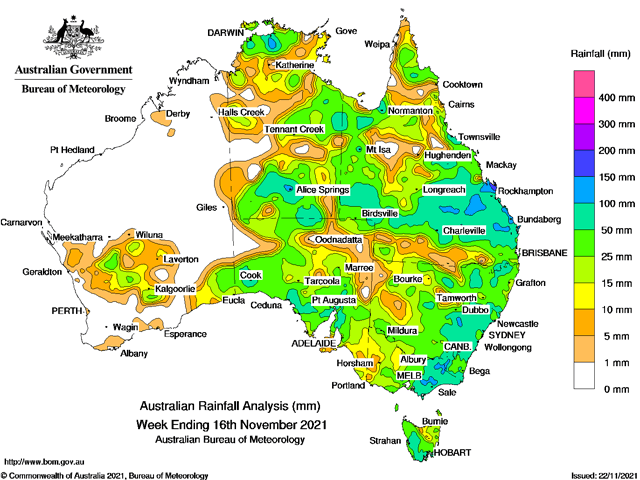Ag Weather Forum
November Rain Swamps Australia Wheat
The world wheat scene continues to be jarred by damaging extreme weather. Summer 2021 brought damaging drought to the U.S. Northern Plains and Northwest, Canadian Prairies, Russia, and Iran; and heavy rain either ruining crops or downgrading quality in the European crop. Now, record rain in sizeable portions of Australia right at harvest time is dragging that crop down in volume but notably in quality.
The Australia Bureau of Meteorology notes that rainfall totals in the week of Nov. 10-16 alone exceeded 100 millimeters (4 inches) in "parts of western and central Queensland; parts of the Hunter, Central Tablelands and areas of the Snowy Mountains districts in New South Wales; and pockets of West Gippsland in Victoria." The Bureau also described rainfall totals of 50 to 100 mm (2 to 4 inches) "in parts of southern South Australia; pockets of the northern, eastern and southern Northern Territory; western and southern parts of Queensland; eastern New South Wales; eastern Victoria; and areas of western to southern Tasmania."
Those heavy rainfall totals formed in some prime wheat sectors of Eastern Australia. New South Wales, southern Queensland, and southern South Australia are big producers. And rainfall of 2 to 4 inches in the Northern Territory is comparable to that amount of rain falling in Arizona in the southwestern U.S. In total, much of eastern Australia has recorded rainfall for the month of November of from 2 to 8 inches -- very poor timing for wheat harvest.
P[L1] D[0x0] M[300x250] OOP[F] ADUNIT[] T[]
Rainfall impact on wheat quality is noteworthy. Ag media reports from Australia indicate that the total wheat crop is still likely to be large, at more than 31 million metric tons (mmt), slightly less than the record 33.0 mmt harvested in 2020-21. However, the quality of the crop is suffering. This is a major concern. Market price spreads between Australia Prime White (APW) and Australia Standard White (ASW) wheat expanded significantly during trading going into the week of Nov. 20-26.
Wheat quality downgrade is "pretty much the same thing for all the wheats," said DTN Cash Grains Analyst Mary Kennedy. "In this case, with the rain, (there can be) sprout damage and low Falling Numbers (indicating the presence of a destructive enzyme known as alpha amylase) ... (an)other factor would be sub-60-pound test weight."
In addition, the rain is not done yet, said DTN Ag Meteorologist John Baranick on Nov. 22. "In Australia, the European (forecast model) is forecasting another 1 to 3 inches to 2 to 4 inches of rain this week. A few dry days are expected afterward that should help, but another system may come in mid-next week for more showers according to the European (model)," Baranick said. There is some model uncertainty after this last full week of November, but the damage to the wheat crop from the month's rain has already been done.
**
Get a full rundown on the 2022 outlook for weather affecting U.S. and international crop areas during the DTN Ag Summit, Dec. 5-7, in Chicago. Visit www.dtn.com/agsummit for more details about the summit and to register. Register before Nov. 26 for the early bird rate.
Bryce Anderson can be reached at Bryce.anderson@dtn.com
Follow him on Twitter @BAndersonDTN
(c) Copyright 2021 DTN, LLC. All rights reserved.




